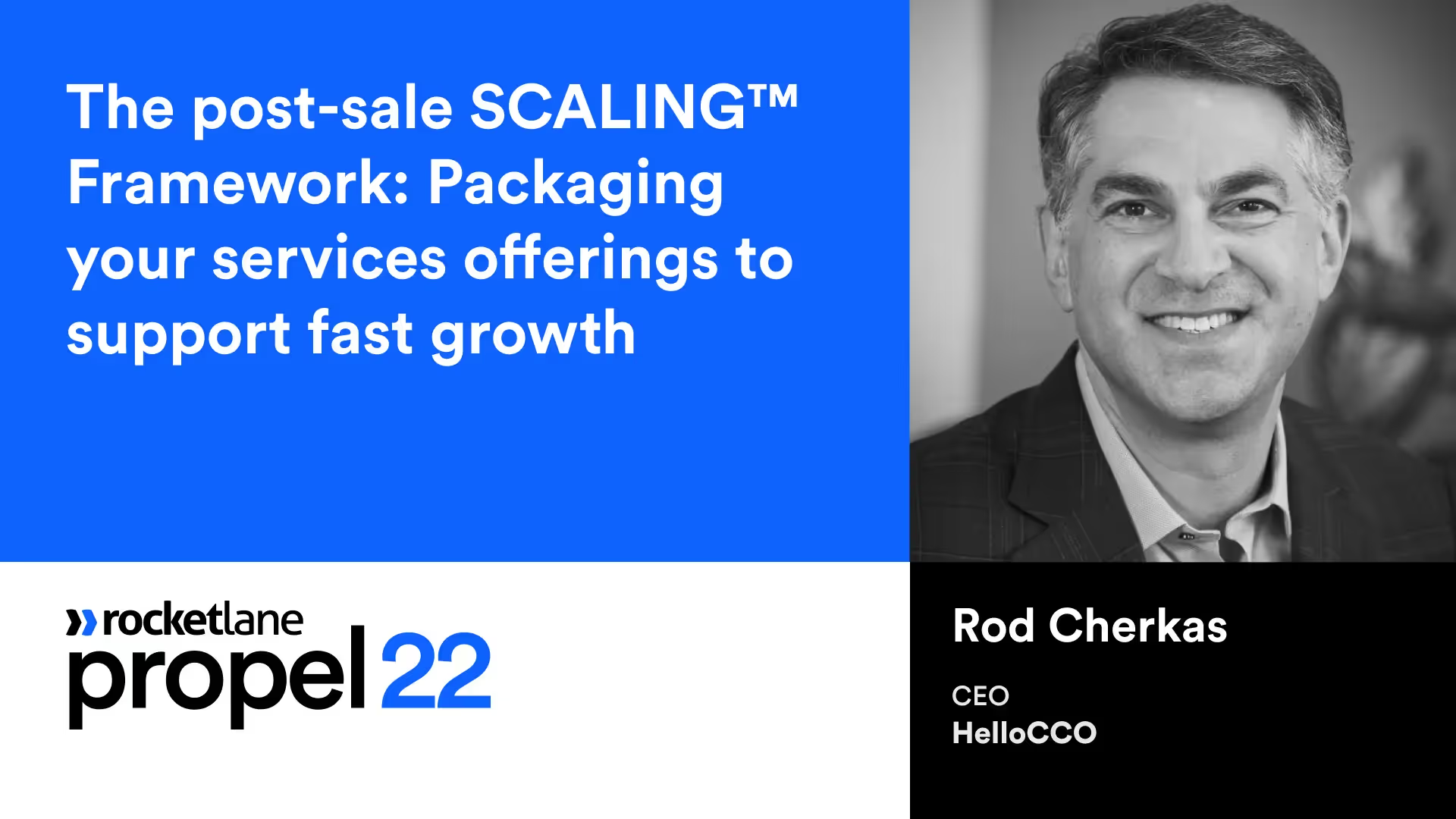Rod Cherkas, the CEO at HelloCCO, shared his learnings and insights on how you can package your services offering to support fast growth.
He spoke about:
- Why packaged implementation offerings are essential to scale
- How to know if your organization is ready for packaged offerings
- The post-sale SCALING™ framework
- The five tips to help you transition to the process of creating packaged offerings
Here are some of the key takeaways from Rod's session.
Why packaged implementation offerings are essential to scale
"Scale drives your organization to help you get more out of the resources that you have in your team."
Scaling is a journey. For starters, you need to have a solid understanding of your customers' needs to make processes more repeatable. You ideally want to put together processes that make your teams more productive and your outcomes more predictable. And packaged offerings can play a huge role in helping your organization scale for five simple reasons.

How to know if your organization is ready for packaged offerings
If you're facing the following challenges in delivery or sales, it's probably time to start thinking about packaged implementations.
Delivery challenges
- Long time-to-first-value
- Different needs by segment
- Results dependent on the person-in-charge
- Indefinite timeline on projects
Sales challenges
- Not talking about the post-sale experience in the sales cycle
- Setting poor/no expectations
- Offering frequent discounts
The post-sale SCALING™ framework
"I've worked with dozens of clients and talked to hundreds of onboarding and implementation leaders about their needs. And I've developed a framework to help you anticipate and understand the decisions you need to make as your business is scaling."

Rod talks about seven different areas that an organization should be looking at improving.
- Structure: How people are organized to work together.
- Customer Value: The experiences and outcomes customers expect from your organization.
- Alignment: How your organization aligns with your company, customer, and cross-functional objectives.
- Leadership: The capabilities, values, and development of people who work for your organization.
- Internal Processes: The systems, data, processes, and workflows that team members use to get their jobs done.
- Network: The community of partners, vendors & thought leaders that create leverage and help erect competitive barriers.
- Growth Drivers: How your post-sale teams contribute to your company's growth and profitability.
Tips to help you transition your organization to creating packaged offerings.
Tip #1: Make sure that it's easy for customers to understand
A modular, "good, better, best" approach lets your customers figure out the right offering and the right price point. And then, in terms of what is delivered, you can have different categories of benefits that you can describe to your customers. The goal is to make it easy for the salespeople to communicate and make it easy for your customers to understand what they're getting.
Tip #2: Make it easy for sales to sell
Salespeople need you to give them straightforward decisions to make.
For this group of customers, choose option A. And for this other group of customers, choose option B.
Give them too many choices, and they could get flustered. So make it easy to price, give them a few options, and enable them. This is good for your customers and shareholders, and it's also great for employee productivity.
Tip #3: Make it easy for your customers to buy these offerings
If you have a scenario where you need to get somebody on the call with a client to understand their needs and then create a custom statement of work, that's a lot of resources and investment being used from the company's perspective.
That doesn't mean that you can't do it, but you should be selective about when that happens. One way you can make it easy to buy is to create offerings in your CRM system, build them out as skews, and have those skews automatically put on the order forms with whatever legal language needs to be there. So along with selecting the number of licenses/seats, they can add on a particular implementation package.
Tip #4: Make it easy for your teams to deliver
Implementation is akin to going to a restaurant and buying something off a menu. Restaurants have a process for building out the recipes they serve their customers. Similarly, there is a recipe for every type of implementation. And there are a couple of benefits to thinking about implementation this way.
One, it creates consistency and predictability in the outcomes you will get. The other thing is that customers like it when their expectation is set around how long implementation will take (because you've done this before for many similar clients). Plus, they will get to outcomes they have already chosen in the sales cycle. And lastly, when you are hiring and staffing, you don't need everybody on your team to be able to work with every single client. So you can have a scenario where you have junior people coming in to do the easier modules, with fewer variations involved. And as people spend more time in your organization working with more challenging clients, they can take on the more complex implementation packages.
Tip #5: Make it easy to engage delivery partners
One of the trends that we've seen over the last couple of years is the rapid growth of implementation partners. There is a growing need for the consulting-partner ecosystem around many companies. And this helps organizations with capacity planning and financials since growing a big implementation/services organization do not always lead to profitability and growth. And so this can be an important way for you to scale your organization without having a lot of people. This doesn't mean that you can't have small teams within your organization; it simply means that you can leverage partners and subcontractors to help. So going back to the restaurant analogy, you can think of delivery partners as franchises. Once you've built out your implementation process and your offerings, you can now train a small group of partners on how to do those things well.



















